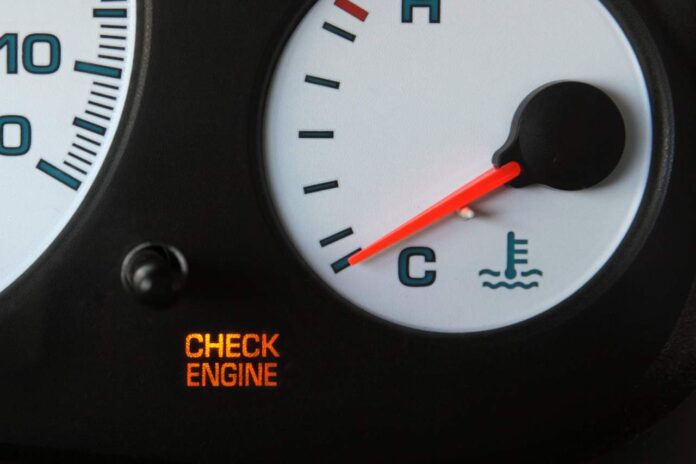One of your car’s means of communication with you is the check engine light, which may occasionally be perplexing to see turn on. We’ll look at typical reasons why an engine light comes on and goes off. The engine light often signals a problem if it comes on. It can indicate a little problem or something more serious. But you might be thinking about that can check engine lights turn itself off? Understanding the potential causes of your light’s flickering can help you deal with it more effectively and maybe prevent having to make expensive repairs. Read along till the very end!
Engine Light – Can Check Engine Lights Turn Themselves Off?
All contemporary automobiles come with a self-diagnostic technology called OBD that continuously provides data to the ECU while scanning all of the sensors and systems in the vehicle. An error code is created and communicated to the car’s ECU if an issue or problem gets discovered after many scans, and the ECU then warns the driver by turning on the Check Engine Light. So, can check engine light turn itself off? Technically? Yes! Your car’s dashboard check engine light may switch off without your intervention.
Usually, the Check Engine Light will remain illuminated until the problem got resolved, or it will even blink if the issue is serious. But occasionally, it switches OFF by itself, and there might be several causes.
What are the Common Reasons Why Check Engine Light Turns Itself Off?
There may be a few underlying causes if you’ve observed that the Check Engine Light on the dashboard turned Off after being ON for some time. You should go to a repair shop and have the ECU scanned rather than freaking out. Anyhow, it could be one of the following issues:
-
Loose Wires
Simple loose cables or battery connections might be the cause, fooling the car’s ECU and providing incorrect signals. The dashboard should get rechecked after making any necessary repairs. Check the connectors or other cables for loose joints.
-
Catalytic Converter
The catalytic converter, which carries most of the volume of the exhaust gases, gets designed to transform dangerous gases into less poisonous forms. If you haven’t had your catalytic converter serviced in a while, probably, it’s partially blocked and clogged. The check engine light may illuminate because of this, and if it gets cleared due to the airflow at higher RPMs, the light will automatically switch off.
-
Change of Fuel
There is a chance that the system detected some gasoline additives and warned your ECU if you accidentally filled it up at a different station than your usual one. The Check Engine Light might automatically turn off once the gasoline has gotten used up or the scan got done again.
-
Temperature
After running for some time, the temperature gauge’s needle returns to normal and remains below the midpoint. The coolant’s temperature may change due to excessive engine revs or a hill climb; turning on the Check Engine Light is a warning. The light would automatically turn off whenever the temperature stabilizes.
-
Ignition Issue
The Check Engine Light might suddenly turn on if the distributor cap, the wires in the ignition system, or any adjacent fluids break loose—a highly unlikely reason.
-
Dirty Pump
The fuel pump is the most neglected component of a car during normal maintenance. If it becomes blocked because of pollution or debris, it may send signals to the vehicle’s ECU and temporarily turn on the Check Engine Light.
-
O2 Sensor
The oxygen sensor, which is closely related to the catalytic converter, is another component that may continuously transmit erroneous signals to the ECU and cause the Check Engine Light to turn on and off by itself.
Can you Drive with the Engine Light On?
There is no issue with usually driving if the Check Engine Light appears on the dashboard, but you must have it examined immediately. By no means should you stop driving if your check engine light is on, and if you don’t hear or see anything unusual, you should keep going but get the car checked before returning home.
If things become too bad, the car will enter Limp Mode, restricting its output and driving capabilities and letting you travel to a local repair facility at lower RPMs. It is a safety feature created by manufacturers to guard against irreparable harm or engine seizure.
How to Fix the Problem by Yourself?
The check engine light will generally not reset unless you resolve the issue. However, now you know the answer for can check engine light turn itself off. So you will need to address the issue, it can take time to reset itself. Usually, it takes a car 10–20 successful cycles before the check engine light gets turned off.
After you start your car cold, drive it until it warms up, then turn off the engine when you’re through with your journey.
The check engine light will reset on its own after 10 to 20 successful cycles, which might take a while if you are confident that you have repaired the issue triggering the check engine light. As a result, using an OBD2 scanner to reset the check engine light is significantly more straightforward.
Final Thought
Your car’s check engine light comes on for various reasons, alerting you to an issue with the engine. The most frequent issues include a faulty catalytic converter, a loose fuel cap, a faulty mass airflow sensor, and a faulty oxygen sensor. Surprisingly, these issues are simple to fix, and some—like unsecured gasoline caps—can even be prevented.
If your automobile completes the two tests, it initially failed three times; the check engine light may turn off on its own. It should not, however, prevent you from driving or taking the automobile in for a checkup. Finally, it is important to learn some fundamentals regarding cars. You can identify and resolve some common issues with some information.
Related Reads: Discover More Content You’ll Love
